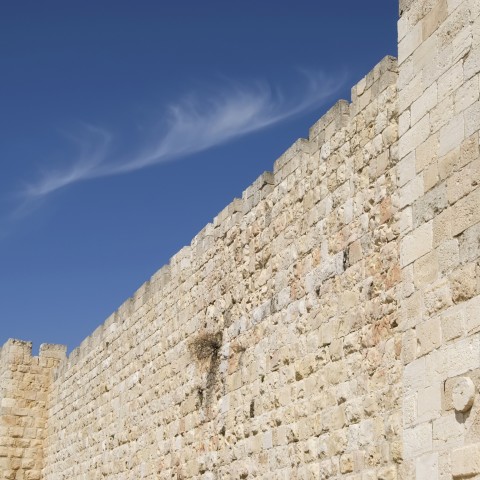
Jewish culture is among the oldest in the world. Whether you’re learning Hebrew for business, planning to visit Israel for pleasure, or just want to gain a better understanding of a culture that has been around for millennia, HebrewPod101 has you covered.
To begin, let’s clarify some confusion between terms. “Hebrew,” “Israeli,” and “Jewish” are sometimes used synonymously, but they do, in fact, have distinct meanings.
Hebrew culture refers to the culture pertaining to speakers of the Hebrew language, which is documented as having been in use by the Israelite tribes who settled in Israel—Canaan at the time—from between at least the fourteenth and thirteenth centuries BCE. The terms Jew and Jewish, on the other hand, originate with the split of the United Monarchy of Israel into the southern Kingdom of Judah and the northern Kingdom of Israel. This split is dated to have occurred between the eleventh and tenth centuries BCE. To make things even more complicated, the term Israelite refers to a Biblical descendant of Israel (the name given to Jacob later in his life), whereas Israeli is the demonym of citizens of the modern State of Israel.
For the purposes of this article, we will use “Jewish” to refer to the culture of all modern descendants of the Biblical Israelites, and “Israeli” to refer specifically to those living in (or originally from) the State of Israel.
Much of Israeli culture is Jewish, but not all Jewish culture is Israeli. Because of the history of the Jewish people, marked as it is by some two millennia of Diaspora (or Jewish communities living outside of Israel) and the many migrations Jews have made from one place to another over the years, Jewish culture is an amalgam of unique customs, traditions, and values. Many of these have been influenced by the numerous host cultures among which Jews have lived (and still live). To put it simply, while a Jew from one part of the world will always find much in common with a Jew from any other part of the world, they are just as likely to find significant cultural differences as well.
For example, a Jew from France and a Jew from Hungary may both pray in Hebrew, but the French Jew would most likely speak French as his native language and the Hungarian Jew would speak Hungarian. And though they would both celebrate the same Jewish holidays, they would almost certainly set the table with different traditional dishes, at least in part. Similarly, while their family and community values would have much in common, their musical and artistic traditions and tastes would probably be distinct. If the two were then to get together with an Israeli friend, they would note yet further distinctions among themselves. For example, while they all might identify as members of the Hebrew race, the Israeli would probably be the only one of them fluent, or at least native, in the Hebrew language.
To better understand the richness and complexity of Jewish and Israeli culture, let’s take a look at some of the different aspects of Jewish culture among both Diaspora Jews and Israeli Jews.
 Table of Contents
Table of Contents
- Values and Beliefs
- Religious and Philosophical Views
- Family and Work
- Judaism and the Arts
- Food Traditions
- Jewish Holidays
- Continue Exploring the Hebrew Language and Culture with HebrewPod101!
1. Values and Beliefs

Jewish values are fundamental to Jewish culture. Indeed, Judaism is very much centered around values-based education and has been concerned with such issues as honesty, honor, and social justice ever since its inception as documented by the Bible. It is important to note here that Judaism is both a religion and a culture. At least in modern times, not all people who identify as Jewish are necessarily religious. For instance, a 2015 Gallup poll found that only 30% of Israeli Jews considered themselves religious, while a full 65% identified as either “not religious” or “convinced atheists.” Nevertheless, just as the Golden Rule is part of many people’s culture the world over, even if they are not affiliated religiously, many Jewish values find expression even among secular Jews. This topic could take up volumes—indeed, it has—but for today, we will focus on the more general aspects of Jewish values and beliefs.
Judaism, for one thing, features an interesting mix of individualism and collectivism. The Hebrew Bible, for instance, begins with the Creation story, according to which all of humanity originated with the first man, Adam. This is often understood as emphasizing that every human life is worth an entire world. On the other hand, Jewish values are greatly centered on the importance of family and community, stressing not only one’s obligations toward the collective but also the happiness and health one derives through connectedness to others.
Looking specifically at Israeli culture and customs, we can see the added elements of solidarity and teamwork that result from obligatory military service, for both men and women, in the Israel Defense Forces (IDF). This experience—לעלות על מדים (la’alot ‘al madim), meaning “to put on a uniform”—has a huge impact on Israelis’ sense of self within the community. Imagine: Just at your prime, right after you’ve finished high school and should be ready to make your own way in the world, you’re placed into service of the collective. This experience can lend a feeling of greater investment in your country, since you have served it and thus feel it is truly your home. (Although in some cases, it can also make people feel they have had enough of the political issues behind the military reality.)
Now let us talk about another key topic here: the relationship between Jewish culture and education. Elementary school education in Jewish culture dates all the way back to the year 75 BCE, and was very possibly in existence prior to that year. This is really no surprise, as in order to be a practicing religious Jew, one must be educated in various subjects, including literacy. The Talmud, the main corpus of Jewish law, mentions, for instance, that children should begin school at age six and specifies the ages at which they should be ready to learn different elements of Jewish law. Additionally, Judaism has long viewed the תלמיד חכם (talmid khakham), or “wise student,” as the model member of society, and the list of Jewish heroes is replete with scholars and sages. In continuation of this heritage, it is interesting to note that Israel is tied with Japan as the country with the second highest percentage of 25- to 64-year-olds with college education.
The immigrant experience is another element at the crux of Jewish cultural identity. Some scholars argue that the very name “Hebrew,” or עברי (‘Ivri), related to the verb לעבור (la’avor), meaning “to cross,” refers to being other or coming from elsewhere. Abraham, the first עברי, is described in the Bible as having crossed into Canaan from the other side of the Jordan River. Even today, Jews do not have to trace their lineage very far back to reach a generation of immigrants. Israel itself is a country of mass immigration, as Jews only began returning to what was then Palestine (now the State of Israel) in any significant numbers in the late nineteenth century. Interestingly, the מצוה (mitzvah), or “commandment,” most often mentioned in the Bible is the injunction to treat the stranger or foreigner with kindness. Moreover, the most important story in terms of Jewish nationhood is probably that of the Exodus, which describes the foreign Israelites’ bondage in Egypt as well as their salvation and subsequent migration to Canaan (later to become Israel), becoming a people united in the Torah on the way.
- → Intrigued? HebrewPod101.com has a lesson on the Top 5 Things You Need to Know About Israeli Society. Make sure to check it out!
2. Religious and Philosophical Views

Jewish culture is, of course, largely based on Jewish religious precepts. That said, there are many secular influences to be found within it as well.
The basis of Judaism as a religion are the commandments and traditions found in the Hebrew Bible, which is called תנ”ך (Tana”kh) in Hebrew. This is an acronym for תורה, נביאים וכתובים (Torah, Nevi’im u-K’tuvim), meaning “Torah, Prophets, and Writings.” The written law and traditions found in the Bible are accompanied by oral traditions believed to date back to Moses at Sinai. These oral traditions were eventually codified and interpreted in written form, beginning around the year 200 CE, being compiled into what is now the Talmud. For religious Jews, there are a full 613 commandments, in addition to many other customs that can vary from community to community.
The basic tenets of the Jewish religious faith attest that there is one God (monotheism) and that God formed a covenant with Abraham long ago, promising him he would be the founding father of a blessed nation if he and his descendants stayed faithful to God. This promise was later repeated and refined with the covenant at Mt. Sinai, in which God, having freed the Israelites (Abraham’s descendants) from slavery in Egypt, presented them the Torah and invoked them to follow its commandments. In reward, God would grant them divine blessings and protection.
Some of the unifying principles that thread through the commandments include:
- The Golden Rule
- Love one’s neighbor as oneself.
- תיקון עולם (Tikkun ‘Olam) – “Repairing the World”
- Jews must work as God’s agents to improve a broken world through justice and good deeds.
- קדושה (K’dushah) – “Sanctification”
- This is the notion of elevating certain acts, items, relationships, and moments to holiness through conscious intent and ceremony. One such example is keeping the שבת (Shabbat), or “Sabbath,” holy and separate from the work week.
The last one is a well-known part of the עשרת הדברות (‘Aseret ha-Dibrot), or Ten Commandments, which also include injunctions to honor one’s parents and prohibitions against murder, adultery, and theft. It is also a commandment to strive to be happy always—one we should probably all try to follow!
Jewish culture, until relatively recently, was essentially religious in nature. It was not until the eighteenth and nineteenth centuries that Jews could comfortably explore a Jewish identity or philosophy not rooted in religion. Thanks to the influence of Enlightenment and Modernist thinking, Jews slowly but surely crystallized various forms of cultural and secular—as opposed to religious—Judaism. Many great thinkers, works of literature, and even entire artistic, political, and social movements stemmed from the secularization of Judaism. One of the most noteworthy cases is Theodore Herzl’s founding of Zionism. A secular Jew from the Austro-Hungarian Empire, he essentially gave rise to a secular Jewish nationalism rooted in the notion of Jewish self-determination and national independence, involving their at least partial return to their historic national home in Israel.
Another way in which non-religious (and even anti-religious) ideologies influenced Jewish culture, Zionism in time became increasingly more socialist in nature. In fact, many of the early Zionists who immigrated to Israel established collective settlements or communes known as מושבים (moshavim) and קיבוצים (kibbutzim), a testament to the influence of socialism in Zionist ideology. In addition, from the founding of the State of Israel in 1948 all the way through 1977, all of the country’s prime ministers were affiliated with the leftist Labor Party (in Hebrew, מפלגת העבודה [Mifleget ha-’Avodah]).
In sum, there is no one Jewish philosophy or ideology. In 2020, Jews in both Israel and elsewhere in the world represent quite an impressive gallimaufry of views and philosophies: religious and secular, left- and right-leaning, pro-Israel, and even anti-Zionist.
3. Family and Work

Family is definitely the social nucleus of Jewish culture. In fact, even in religious circles where synagogue attendance is part of daily life, many of the most important parts of Jewish life occur at home rather than in public. This is true to some extent with secular but traditional Jews, as well.
Depending on the particular Jewish community, families can be more patriarchal or egalitarian, but in either case, both paternal and maternal roles are given great importance. Children are also extremely important in Jewish culture, viewed as the assurance of Judaism’s future and thus greatly valued and invested in. For example, Judaism celebrates a child’s coming of age through the celebration of a בר מצוה (Bar Mitzvah) for boys and a בת מצוה (Bat Mitzvah) for girls. Children, conversely, are expected to honor their parents as instructed in the Ten Commandments.
One of the main ways that families spend time together and get to know one another is through sharing meals on Sabbath and Jewish holidays. The Sabbath is a day of rest for religious families, so no work is done. This leaves a lot of quality time to spend together talking, singing, playing games, or going for walks. In secular families, the Sabbath may be a day for bike rides in the park or seeing a movie with family and friends. The same is generally true for Jewish holidays.

You can also find reflections of Jewish culture in business spheres and work environments. Jewish culture fosters a very strong work ethic, perhaps due in large part to the millennia of immigration that required Jews to be hard-working and flexible in order to survive—and certainly to thrive as they have. In the case of Israel, as the country was quite literally built up from swamps in modern times by חלוצים (khalutzim), or “pioneers,” there are some big shoes to fill in doing justice for their hard labor.
In any case, Israel follows a six-day work week and is characterized by a highly productive and competitive workforce, especially in light of the high percentage of well-educated and qualified workers. In general, Jews have been found to be the best-educated religious group the world over, most receiving around 13.4 years of formal schooling and a majority pursuing university degrees. Israel, in particular, has been dubbed the Startup Nation due to its staggering number of entrepreneurs.
4. Judaism and the Arts
Judaism’s relationship with art is twofold. On the one hand, Judaism has maintained its own artistic aesthetics for millennia (generally referred to as Judaica in the visual arts), and has produced its own distinct musical culture mainly for prayer and other religious applications. On the other hand, a highly disproportionate number of Jews have participated and continue to participate in the arts.

First of all, Jews have always been known as a literary people. In fact, they have been known from Biblical times onward as עם הספר (‘Am ha-Sefer), or “People of the Book.” Apart from the huge contribution to Western culture that the Hebrew Scriptures represent, Jews have also given the world many other important works. Examples of such Jewish literature include the corpus of mystical-philosophic texts referred to as קבלה (Kabbalah) and Maimonides’ humanistic Guide to the Perplexed in centuries past. More modern Jewish authors include Sigmund Freud, Franz Kafka, Ayn Rand, Allen Ginsburg, and Philip Roth. Modern Israel has also made its own unique contribution to world literature through luminaries such as Chaim Nahman Bialik and S. Y. Agnon.

In terms of Jewish art, Judaica typically serves a double function, being both aesthetic and functional in the performance of various Jewish rituals. For instance, it is common to find silver candlesticks on daily display in Jewish homes, though they are used for lighting the candles on Friday eve or on the eve of holidays. Another example is the ornate מזוזה (mezuzah), a cylinder containing scroll with a portion of the Torah. This is typically found mounted on the door frame in the entrance to Jewish homes. Other common Judaica items are:
- חנוכיות (khanukiyot) – “Hanukkah menorahs”
- Decorative plates for the symbolic items that get served during the Passover Seder
- Illustrated marriage contracts known as כתובות (ketubot)
Apart from Judaica, Jews have made an immense contribution to the visual arts in modern times. Some of the more famous examples of this include Camille Pissarro, Amedeo Modigliani, and Marc Chagall. There have also been a number of noteworthy Jewish photographers, such as André Kértesz, Annie Leibovitz, and Alfred Eisenstaedt. And, of course, in the genre of filmmaking, the list of prominent Jewish cinema stars is virtually endless. Some of the more famous names include directors Woody Allen, Stanley Kubrick, Roman Polanski, and Steven Spielberg, and actors Dustin Hoffman, Richard Dreyfuss, James Caan, Lauren Bacall, Natalie Portman, and Gal Gadot.

Music is another art of great importance to Jewish ritual, such as in sung prayers and in the cantillation system for chanting the Torah. There is also a great deal of traditional Jewish music that revolves around weddings and other celebrations, such as the klezmer music of Eastern Europe and the Ladino music of the Iberian Peninsula, Northern Africa, and the Mediterranean Basin.
Jews have also contributed immensely to many different music genres outside of the strictly Jewish aesthetic. In classical music, names such as Felix Mendelssohn, Joseph Joachim, Arthur Rubinstein, Jascha Heifetz, and Leonard Bernstein are but a few on the seemingly infinite list of famous Jewish classical musicians. In the world of popular music, George Gershwin, Bette Midler, Bob Dylan, Billy Joel, Neil Diamond, Judy Garland, Barbara Streisand, Benny Goodman, and David Lee Roth are but a handful of famous and influential Jewish figures.
Modern Israel has its own vibrant and diverse music scene, taking elements from both traditional Jewish music from the many countries of its immigrants, as well as from Arabic, Western, and other non-Jewish sources. For instance, there is a strong industry of מוזיקה מזרחית (muzikah mizrakhit), or “Eastern music,” based on the quarter-tone-infused strains of musical cultures from countries like Yemen, Morocco, and Iraq.
There is likewise an ever-growing Hebrew-language mainstream music industry. Its music sounds similar to rock, pop, and other international musical styles, but in Hebrew and tinged with the Mediterranean sun. Israeli artists have participated in the Eurovision Song Contest 42 times (winning four times), and a number of Israeli artists—such as David Broza, Yael Naim, and Balkan Beat Box—have done crossover work in English (and to a lesser extent, in other languages).
5. Food Traditions

There is a Yiddish saying according to which the home is like a body, and the kitchen is its heart.
In Jewish culture, food is an absolutely vital part of both daily life and special occasions, with its unique ability to both nourish and signify. Typical Jewish foods include braided loaves of חלה (khallah), or “challah bread,” served at Shabbat and matzah ball soup. The latter is famous for using the unleavened Passover bread, מצה (matzah), to make dumplings that can either sink or float depending on the chef. There is also babka, a yeasted sweet bread.
Culinary traditions are one aspect in which Jewish communities differ from one another. This is largely because local dishes traditionally depended on the availability of ingredients, though influences from local non-Jewish cuisine have also played a role. For example, Hungarian Jews are likely to have a grandmother famous for making csirke paprikas, or chicken with paprika (holding back the sour cream, which non-Jewish Hungarians would almost invariably add, so as to keep it kosher), whereas a French Jewish cook might serve chopped liver or papeton d’aubergines, an eggplant gratin.

In Israel, all of these different culinary cultures meet and mix. This means there are both remnants of (more or less) authentic regional traditions from the many mother countries from whence Jews immigrated to Israel, as well as fusion cuisine influenced by places as distant from each other as Bulgaria, Morocco, and Poland. One thing you can be sure of is that if you visit a Jewish home, no matter the geographical origins of its inhabitants, someone should be asking you pretty soon if you’re hungry!
6. Jewish Holidays

There are many Jewish holidays throughout the year, each with its own distinct flavor. Apart from the Sabbath, which is observed every week from Friday night to Saturday night, there are major and minor חגים (khagim), or “holidays.” There are also several fast days and numerous modern Israeli holidays instituted since the founding of the State of Israel in 1948.
Note that Judaism uses a lunar calendar, so the Gregorian dates of Jewish holidays will vary from year to year. The main Jewish holidays are as follows:
- ראש השנה
Rosh ha-Shanah
“New Year” (literally: “Head of the Year”)
This is the Jewish New Year, which falls somewhere between September and October. It celebrates the creation of the universe as recounted in Genesis.
- יום כיפור
Yom Kippur
“Day of Atonement”
This is the holiest day of the year, coming nine days after the New Year. It commemorates the destruction of the Holy Temple in Jerusalem. It is a fast day and, at least for religious Jews, a day of solemn prayer and reflection on which they ask God for forgiveness for their sins of the previous year.
- סוכות
Sukkot
“Feast of Booths”
This holiday falls around September-October and lasts a week. It commemorates the Israelites’ forty-year voyage from Egypt to Canaan as recounted in Exodus, as well as their itinerant lifestyle during this time. The holiday is celebrated by building a makeshift outdoor home similar to a shack, though they can get pretty fancy. Religious Jews live in these shacks for the entire week, eating, talking, and even sleeping in them. Sukkot ends with שמחת תורה (Simkhat Torah), or “Rejoicing with the Torah,” which is a joyous celebration marking the end of the Torah’s annual reading cycle and the beginning of a new one.
- חנוכה
Khanukkah
“Hanukkah”
This is the Festival of Lights, celebrating the victory of the Jewish Maccabees against the Seleucid Empire in the second century BCE. Falling more or less around Christmastime, it is a joyous holiday in which special candelabras are lit for eight nights in a row, parties are held, and gifts are typically exchanged.
- פורים
Purim
“Purim”
Celebrating the Jews’ narrow escape from annihilation at the hand of the Persian Empire, thanks to the intervention of the Jewish heroine Queen Esther, this holiday is celebrated with costume parties and the exchange of gift baskets brimming with food and drink. It falls sometime around March.
- פסח
Pesakh
“Passover”
This holiday, lasting a week and falling near Easter, celebrates the Exodus story. Its highlight is an elaborate and symbol-laden meal called the סדר (Seder), literally meaning “Order.” It tells the story of slavery and liberation using numerous foods and rituals to recount the different elements of the tale. Religious Jews eat only an unleavened bread called מצה (matzah) for the entire week, abstaining from other flour-based foods.
- שבועות
Shavu’ot
“Feast of Weeks”
Falling seven weeks after the beginning of Passover, this holiday continues the Exodus story, this time commemorating the Israelites’ reception of the Torah at Mt. Sinai. It is customary to eat dairy foods, such as blintzes and cheesecake, on this holiday.
- יום השואה
Yom ha-Sho’ah
“Holocaust Remembrance Day”
This solemn day, usually falling in April, commemorates the millions of victims murdered in an attempted genocide during the Holocaust, as well as the heroism of those who lost their lives fighting against Nazism and Facism in the resistance movements.
- יום הזיכרון
Yom ha-Zikaron
“Memorial Day”
This day commemorates those who fell in military service defending the State of Israel, as well as those murdered by terrorist acts.
- יום העצמאות
Yom ha-’Atzma’ut
“Independence Day”
The day after Memorial Day, this is Israel’s celebration of its independence as a modern state, declared in 1948. It is celebrated with grand firework displays, barbecues, and other festive get-togethers, in addition to military parades and displays.
7. Continue Exploring the Hebrew Language and Culture with HebrewPod101!
We hope you found this lesson interesting and informative. There is no better way to master a language than through immersion, which includes an understanding of the culture surrounding and underpinning the language. In the case of Judaism, the language and culture are inextricably woven together. And in view of the fact that Israel is the one and only Jewish state in the world, it is a great idea to learn about that culture if you are planning to visit. This will make your time that much more interesting, enjoyable, and meaningful.
Are there any aspects of Jewish or Israeli culture you’d like to know about that we didn’t cover here? Is there anything you’d like to know more about? We’re always happy to receive your feedback, as it’s our goal to always provide you with interesting and engaging lessons that speak to your needs and interests. We look forward to hearing from you.
For now, shalom!










